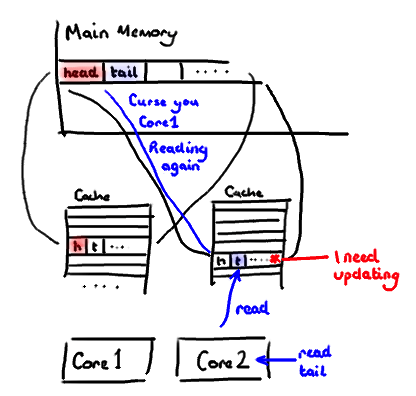好不容易发现了自己的平庸,但却为时已晚,这才是最残忍的事啊。
周末在家闲来无事,翻看技术文章,发现一个叫做disruptor的高性能内存队列占据了头版头条,好奇其高性能的秘密,于是对该框架进行了一些简单的研究。disruptor并非新出,而是从2013年到现在经历了3个大版本的迭代。本文有如下几个部分:
disruptor如何使用?
disruptor高性能的秘密?
如何使用 核心概念:
EventFactory:用于生成一个事件提供消费者消费
EventHandler:消费者处理器
事件和生产者:无内部接口,可以自己封装实体对象和RingBuffer
RingBuffer:核心数据结构,可以理解为环形缓冲,disruptor高性能秘密
WaitStrategy:消费者阻塞时候的等待策略:SleepingWaitStrategy,BlockingWaitStrategy,BusySpinWaitStrategy,YieldingWaitStrategy
Disruptor:disruptor框架入口,进行相关配置
事件和工厂
public static class LogEvent
String content;
public void setContent (String content)
this .content = content;
}
}
public static class LogEventFactory implements EventFactory <LogEvent >
@Override
public LogEvent newInstance ()
return new LogEvent();
}
}
消费者
public static class LogEventHandler implements EventHandler <LogEvent >
@Override
public void onEvent (LogEvent event, long sequence, boolean endOfBatch) throws Exception
System.out.println(Thread.currentThread().getName() + ",seq=" + sequence + ",event=" + event.content);
}
}
生产者
public static class LogEventProducer
private final RingBuffer<LogEvent> ringBuffer;
public LogEventProducer (RingBuffer<LogEvent> ringBuffer)
this .ringBuffer = ringBuffer;
}
public void onData (String content)
long seq = ringBuffer.next();
try {
LogEvent logEvent = ringBuffer.get(seq);
logEvent.setContent(content);
} finally {
ringBuffer.publish(seq);
}
}
}
public static void main (String[] args)
LogEventFactory eventFactory = new LogEventFactory();
int bufferSize = 16 ;
Disruptor<LogEvent> disruptor = new Disruptor<>(eventFactory, bufferSize,
(ThreadFactory)Thread::new ,
ProducerType.MULTI,
new BlockingWaitStrategy());
disruptor.handleEventsWith(new LogEventHandler());
disruptor.start();
RingBuffer<LogEvent> ringBuffer = disruptor.getRingBuffer();
LogEventProducer producer = new LogEventProducer(ringBuffer);
for (int i = 0 ; i < 20 ; i++) {
producer.onData("this is a log event i=" + i);
}
}
高性能的秘密 如下是高性能的秘密,我个人理解和简述:
lock-free ArrayBlockingQueue使用lock实现并发控制,无论get或者put,都是将final ReentrantLock lock;进行上锁,毋庸置疑当c/p大量并发时会有性能损失。
相比,disruptor通过’分离竞争点’解决大量cp并发问题。即当:
1p-1c:无特殊
1p-多c:每个消费者使用独立的seq,即分离竞争点。disruptor不会清理数据,循环覆盖。
多p-多c:多p之间采用cas操作。内部实现AtomicLong
多p-1c:与3一样
这种分离竞争点技术思想,也用于LongAdder以及ConcurrentHashMap。
伪共享和缓存行填充
L1cache是计算机体系结构中重要组成部分,我们都知道L1Cache的作用:缓存memory热点数据,以加快cpu访问。在多核时代,由于不同cpu的缓存中拥有相同内存区域的不同副本,因此,L1Cache之间的同步是有其成本的,这需要使用内存控制器以及MESI协议。缓存以行作为最小加载单元(64byte=8个long),如上图,当队列首位指针(disruptor使用seq),被加载到相同的缓存行的时候,c1处理生产,c2处理消费,而首位指针其实是独立的但却进行了共享(伪共享),导致L1Cache的缓存行刷新。
解决办法很明显,h,t分别放到不同的缓存行上。如何放?Padding。因此看源码时有如下代码:
性能优越性 给一个官方disruptor与ArrayBlockingQueue的性能测试结果:
参考链接
------------------------------------------------------------------------------------------------------------------------------
Enjoy it ? Donate me ! 欣赏此文?求鼓励,求支持!
Enjoy it ? Donate me ! 欣赏此文?求鼓励,求支持!



